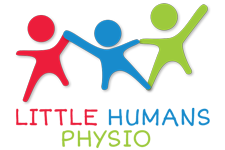Introduction
Normal growth and development can be varied amongst children. The appearance of a child’s legs and feet compared to their peers is often a concern for parents, particularly if the child is tripping over or appears clumsy. In most cases this is simply the consequence of a postural variation which will correct as the child grows and develops. However, an examination by a health professional should be performed to make sure there is no other conditions causing a postural variation. The following is a list of common postural variations commonly assessed at Little Humans Physio.
Intoeing
Intoeing is a condition in which a child turns either one or both feet inwards when they are walking. It is commonly occurs due to the following:
Metatarsus Adductus
Metatarsus Adductus is a curvature of the outside of the foot due to the baby’s position in the womb. Children may only require monitoring or exercises if they have a flexible foot. Children with stiff feet that cannot be corrected require the application of a series of casts to help straighten their feet.
Internal Tibial Torsion
Internal tibial torsion is an inward rotation of the lower leg bone. It is typically present in children aged between 1 and 2 yrs of age. As a child grows the lower leg bone should naturally rotate outwards.
 Femoral Anteversion
Femoral Anteversion
Femoral Anteversion is an inward rotation of the thigh bone. Peak femoral anteversion occurs around the 3-7 years of age and usually corrects by the age of 10.
A physiotherapy consult is particularly important in children demonstrating the following:
- Intoeing only on one leg
- Severe intoeing not improving with time
- Stiff feet
- Decreased functional abilities
- Decreased participation levels
Out- Toeing
Out- toeing is less common in children compared to intoeing. It occurs as a consequence of outward twisting of the lower leg bone, tightness of the muscles around the hip or backwards angulation of the thigh bone. Fortunately, out-toeing spontaneously resolves in the majority of cases as a child grows.
Bow legs
Bow legs are evident when a child stands with their feet together and their knees do not touch. It can become
more evident as a child begins walking. Bow legs should start to resolve as a child reaches the age of three.
Knock knees
Knock knees typically occur between the ages of three and five and often occur in children who have previously demonstrated bow legs. When standing these children are unable to touch their ankles together when their knees are touching.
A physiotherapy consult is particularly important in children demonstrating the following:
- Asymmetry is noted between legs
- Bow legs or knock knees appear severe
- Associated with pain or limp
- Previous fracture in the lower leg bone
- Child appears short in stature for age
Conclusion
Variations in walking or postural alignment in children will often spontaneously resolve as the child grows and develops.However, variations may be a sign of other more serious conditions that may warrant medical intervention and therefore require a review by a health professional. If your child is demonstrating any of the above postural variations and you would like a physiotherapy review contact us or book an appointment online.
References
Jacobs, B. (2010). Toe walking, flat feet and bow legs, in-toeing and out-toeing. Paediatrics and Child Health, 20(5), 221-224.
Sass, P., & HSass, P., & Hassan, G. (2003). Lower extremity abnormalities in children. American Family Physician, 68(3), 461-468.
Svenningson, S., Apalset, K., Terjesen, T., & Anda, S. (1989). Regression of femoral anteversion: A prospective study of intoeing children. Acta Orthopaedica Scandinavica, 60(2), 170-173.
Victorian Paediatric Orthopaedic Network. (2015). Paediatric orthopaedic resources for health professionals. Retrieved from: https://www2.health.vic.gov.au/hospitals-and-health-services/patient-care/specialist-clinics/vpon/resources-health-professionals


